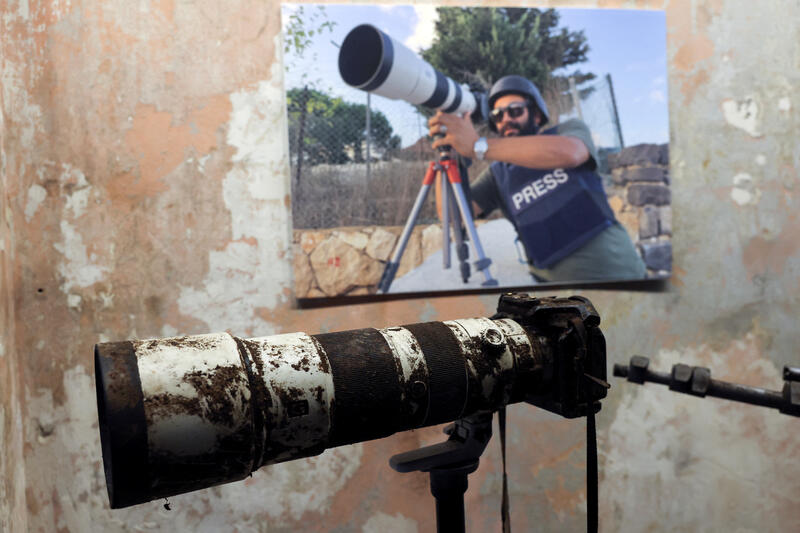Dealing with the threat of war has become the “new normal” for these Middle East newsrooms

The camera that belonged to Lebanese Reuters journalist Issam Abdallah who was killed on 13 October 2023 by Israeli tank fire. 7 Dec 2023. REUTERS/Emilie Madi
In August 1982, an Israeli phosphorus shell hit the Beirut offices of influential Lebanese newspaper An-Nahar, setting them on fire and halting newsroom operations as it entered its 50th year of publishing. The incident serves as a reminder that journalists and news outlets have long been on the frontline of the region’s conflicts.
Amid the ominous threat of a regional war in 2024, Nayla Tueni, CEO and editor-in-chief of An-Nahar, once hailed by the New York Times as “the newspaper of record for the entire Arab world,” and Noa Landau, deputy editor-in-chief of Haaretz, Israel’s influential and longest-running newspaper, share how their newsrooms support their staff and stay true to their journalistic principles while under extreme pressure. Both suggest a wider war, in many ways, would only be a continuation of what the region has suffered in both its recent, and more distant, history.
Dealing with historical trauma
“We've had two martyrs at the newspaper since 2005, we faced a lot of revolution, street issues. We faced the 4th of August. We always faced things in Lebanon. So unfortunately, it's something normal.” Tueni speaks of ‘the 4th of August’—when ammonium nitrate stored at the Port of Beirut exploded accidentally in 2020 killing more than 200 people and injuring 1,000s—in much the same way Israelis understand the term ‘the 7th of October’. The dates are now shorthand for a shocking event that ruptured each nation’s psyche as well as directly impacting journalists covering the stories.
Both Tueni and Landau say these two events, forever etched in their countries’ respective histories, required their newsrooms to offer therapy to journalists affected. “After the bomb on the 4th of August, we did group therapy. We talked, we exchanged, they expressed themselves. If they needed any more specific follow up we were here to guide them, to send them to someone,” says Tueni. For a country steeped in conflict going back decades, An-Nahar’s younger journalists are also able to learn from their older colleagues who’ve covered the various wars, sectarian conflicts and political assassinations that have afflicted generations of Lebanese citizens.
Similarly, after 7 October, Landau says, “we did something kind of unique in our organisational history, which is we brought therapists to give free therapy sessions for everyone that felt traumatised.” She says during the Hamas attack, several Haaretz journalists were shot at while reporting. Haaretz diplomatic correspondent Amir Tibon, who lived in the Nahal Oz kibbutz near Gaza, had to be rescued after 10 hours locked in the safe room with his family.
Balancing war and non-war coverage
Tueni says in the event of an all-out war, plans would be implemented to have more journalists on hand to cover the news. “We work on having more staff, more teams, more colleagues standing by, even if it's not their time to sit on the desk,” she explains. This is despite Lebanese journalists effectively being “always on standby for any dramatic situation,” she says. Though reporters on other beats are “ready to help” to cover any potential slide into war, Tueni insists on the importance of balance to maintain a breadth of coverage, across all areas of news, away from war.
Like Tueni, Landau shares a sense of war weariness. Having adjusted to this “new normal”, as she describes it, Haaretz is no more or no less prepared for a potential wider escalation in the war. It’s simply more of the same as she sees it. “It's not very different if the missiles are from, you know, A, B or C, in terms of the work that we do. Of course, we don't want the situation to escalate, but professionally speaking, we'll do the same again,” she adds.
The immediate nature of conflict inevitably provides a distraction from perhaps longer term journalistic projects that most news outlets across the world don’t need to contend with. For example, Tueni speaks of an upcoming pan-Arab version of An-Nahar whose planned September launch would inevitably be overshadowed by war. Similarly, Haaretz’s plans for a “big, fancy climate desk” were put on hold by 7 October, says Landau.
Mitigating extreme risk
Being a newsroom editor in a frequently war-torn country creates a heightened sense of responsibility for the reporters under your wing, says Tueni. As well as professional concern, there's also a sense of personal anxiety, especially for colleagues “whose homes are in the South [of the country] or in Dahieh,” the Beirut district that is often hit hardest during Lebanon's conflicts. “We're always worried and we feel responsible for our journalists,” she says.
Tueni assumed the top role at just 22-years-old in 2005 when her father and then editor, Gebran Tueni, was assassinated after writing an editorial against the presence of Syrian troops in Lebanon. The risks that reporters in the region have historically faced now weigh more heavily given the toll on journalists in Gaza since 7 October. Israel’s invasion of the Palestinian territory has already claimed the lives of well over 100 journalists and media workers, highlighting how journalists are not immune to the consequences of war. Within the first few days of the war, Reuters photojournalist Issam Abdallah was killed by Israeli tank fire in southern Lebanon. The Committee to Protect Journalists has accused Israel of targeting Palestinian journalists and their families.
An-Nahar does offer training to its reporters with guidance on “how to cover war, where they have to be, where they have to stand, how they have to take care.” But the final call on whether a journalist goes to report lies with the journalist themselves, says Tueni, allowing them to prioritise their own safety. "If you don't want to go, you don't go," she says. She acknowledges, though, that for many journalists, especially those covering war, they have made it their professional duty to run towards danger. “This is the mission of a journalist. At the end of the day, it's war, let's be practical. You cannot protect them 100%,” she concedes.
Defying pressure to 'rally round the flag'
According to Reporters Without Borders (RSF) who place Lebanon 140th out of 180 countries in their 2024 Index, “genuine freedom of expression does exist” in the country, yet news media are highly politicised and controlled or owned by the various political factions or family dynasties. This includes Hezbollah which operates its own Al Manar TV channel and a multilingual news website. The militant group would likely be one of the main actors in the event of a regional war and has a strong influence within Lebanon.
Would Tueni or An-Nahar face pressure from the various Lebanese factions to cover the war in a particular way, given the heightened stakes? The only pressure she is interested in, she says, is living up to the newsroom’s journalistic ideals. “We always have to tell the truth about what's happening, and we have a mission. To [share] our words and try to reach a wider audience and politicians, and try to also make an impact on the community, on the government, even the world. So this is the pressure," she says. "The pressure is to save our country. We keep An-Nahar’s point of view, An-Nahar’s beliefs, the An-Nahar mission, An-Nahar’s legacy and we implement it even during war.”
It is these core journalistic principles, to publish the truth and resist the pressure to blindly ‘rally around the flag’ when the pressure to do so is most extreme, which Landau believes separates Haaretz from other Israeli publishers. According to RSF, in Israel, “a majority of the media has increasingly relayed the government’s propaganda in favour of the war, and critical voices find it difficult to be heard.”
Landau expands on this point saying: “In other media outlets, there's a lot of self-censorship. [They] believe that in times of war, they need to be more patriotic because their audience doesn't like them showing things from the other side of the fence.” In contrast, she points to a recent Haaretz investigation showing the IDF’s use of Palestinian human shields in Gaza, a criticism of the military that many disapproved of. In July, it reported on the military’s use of the Hannibal directive on 7 October that risked the lives of hostages. More recently, its editor-in-chief Aluf Benn claimed Benjamin Netanyahu’s real goal is “the prolonged occupation of Gaza” over the return of hostages.
How does Haaretz defy urges to show unwavering support to the country and its military as it continues its war in Gaza and as a wider conflict may be on the horizon? “We just publish,” says Landau simply. “We think that’s journalism and that's what we do. Sometimes our readers appreciate it, sometimes they don't.”
Israeli-Palestinian magazine +972 revealed 613 news articles in Israel were totally barred by the military censor in 2023, while 2,703 were partially redacted. Censorship rulings can be appealed but there is still a legal requirement for any journalist working within Israel or an Israeli publication to submit articles that concern ‘security issues’ for approval by the authorities. This is rare among countries considered to have a free press. “No other self-proclaimed ‘Western democracy’ operates a similar institution,” wrote +972’s Haggai Mattar.
This calculation over what can be, or is, written about when it comes to Israeli military matters is also apparent in the use of embedded correspondents. Landau accepts it’s often the only way to get access but by doing so journalists are led to only “see a specific side of the story.” Being aware of its limitations means Haaretz makes “a bigger effort to bring also the perspective and voices of people,” particularly Gazans, she says. When it comes to using third-party content such as videos and images of the war from everyday Gaza residents Haaretz is careful to frame it as such and not take it at face value.
Having become used to reporting on extreme violence and man-made tragedy, both An-Nahar and Haaretz offer valuable lessons on how to stay resilient, compassionate and principled under the most challenging of circumstances. A wider war in the region would, tragically, test them once again to their limits.
In every email we send you'll find original reporting, evidence-based insights, online seminars and readings curated from 100s of sources - all in 5 minutes.
- Twice a week
- More than 20,000 people receive it
- Unsubscribe any time
signup block
In every email we send you'll find original reporting, evidence-based insights, online seminars and readings curated from 100s of sources - all in 5 minutes.
- Twice a week
- More than 20,000 people receive it
- Unsubscribe any time






